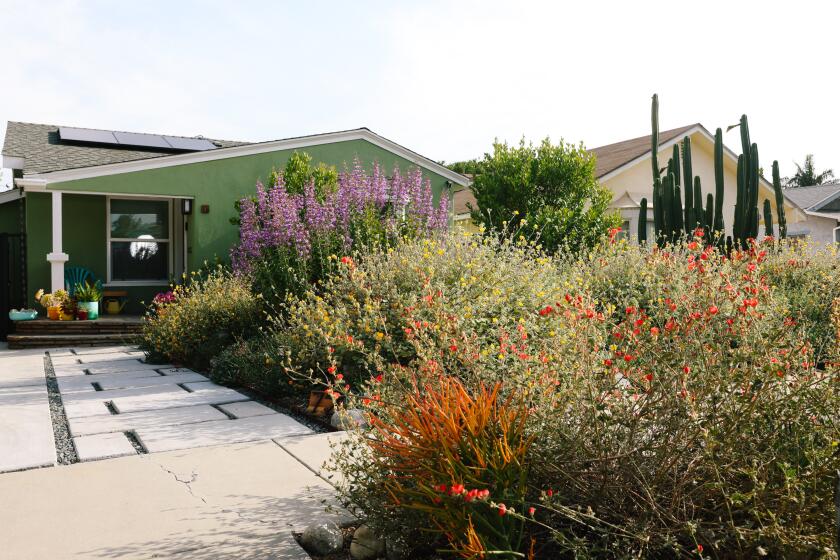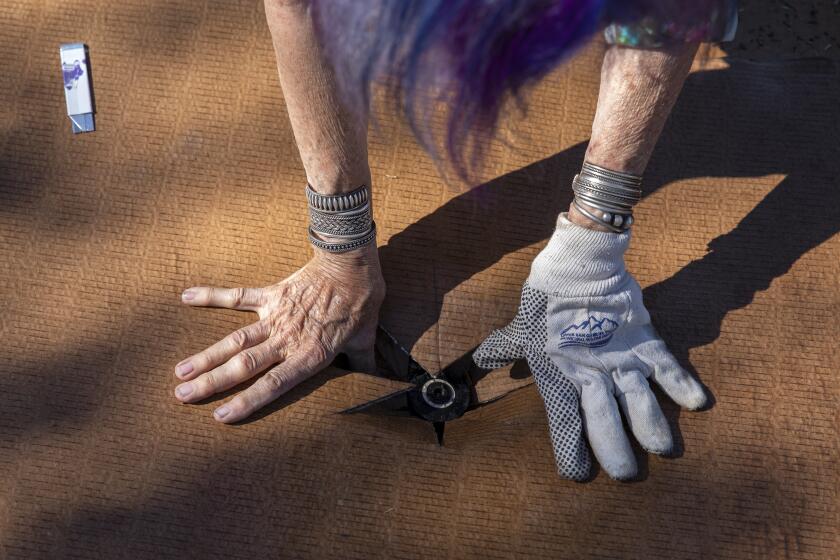18 native plants that’ll turn your yard into a grass-free wonderland
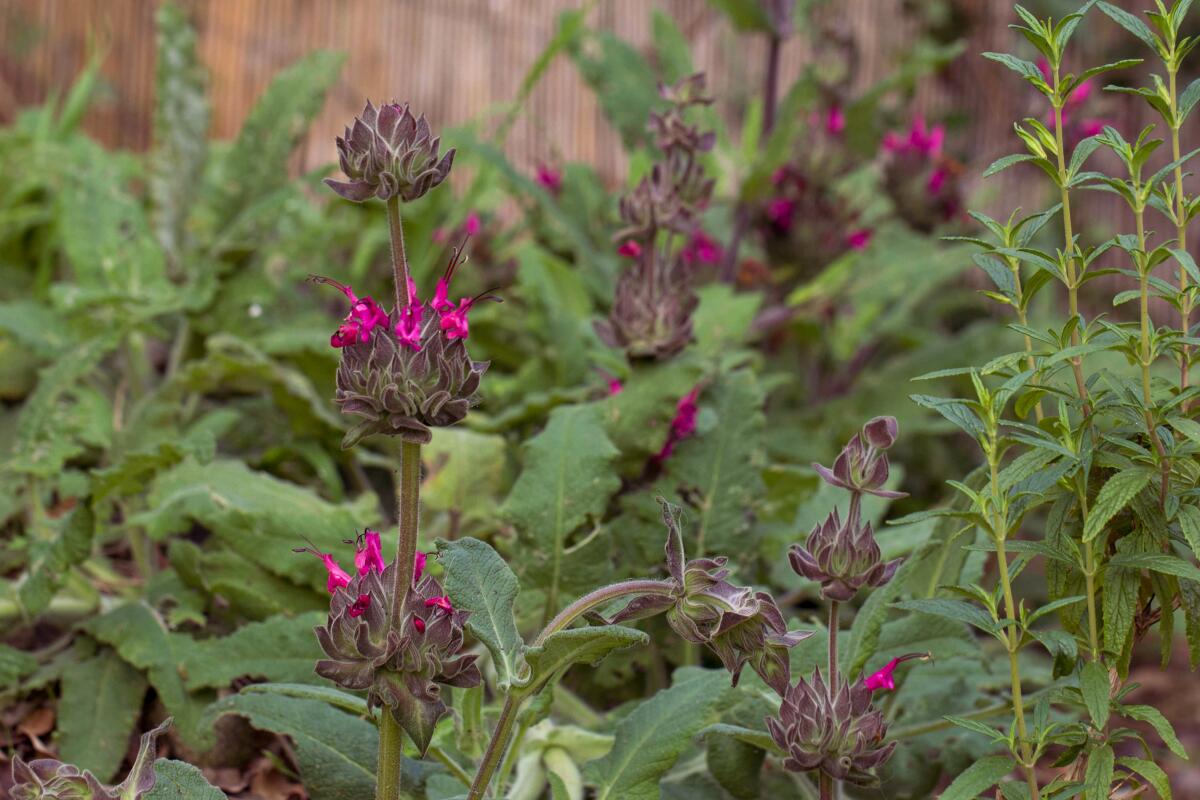
Welcome to the October edition of the L.A. Times Plants newsletter, with a list of this month’s plant-related activities and upcoming events.
But first, let’s celebrate one of my favorite things about fall: It’s cool enough that we can start planting again — especially if we want to add California native plants to our landscape.
If you’re one of the many who have reduced or eliminated your lawn, then it’s time to stock up on plants for a habitat landscape. But what about all that empty space in between your new plantings? Some people are happy to just fill those areas with mulch. That seems like a missed opportunity to me, when there are so many beautiful native ground covers that can fill in those spaces with fragrance, flowers and evergreen textures and colors.
Sign up for our L.A. Times Plants newsletter
At the start of each month, get a roundup of upcoming plant-related activities and events in Southern California, along with links to tips and articles you may have missed.
You may occasionally receive promotional content from the Los Angeles Times.
I asked a few experts for their favorite native plant ground covers, hoping to narrow the choices from hundreds to choose from. You can get more details by visiting the CalScape database of all California native plants, or the databases maintained by the Theodore Payne Foundation and Tree of Life Nursery. A tip when you’re searching: use the botanic names because common names can differ.
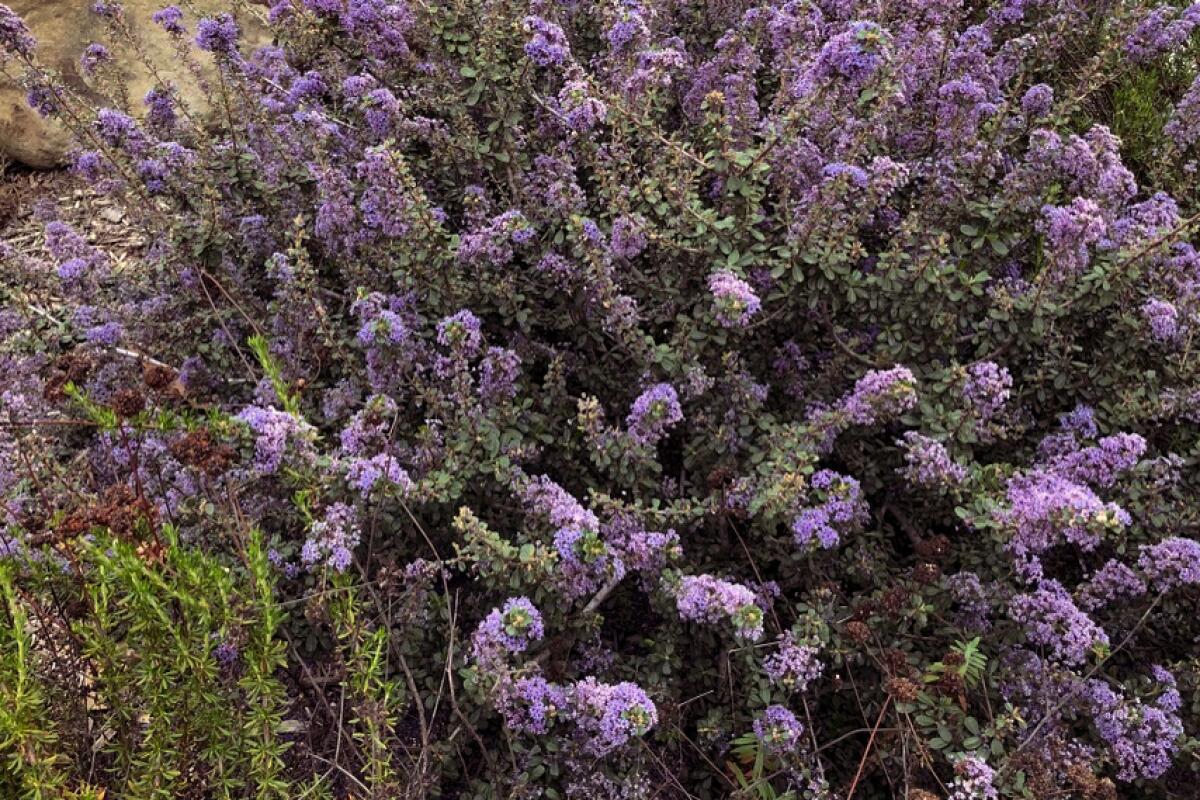
Horticulturist Carol Bornstein wrote the book on landscaping with native plants (“California Native Plants for the Garden,” with co-authors David Fross and Bart O’Brien). She joined Parker Davis of Hardy Californians Nursery, Theodore Payne Foundation’s executive director Evan Meyer and horticulture director Tim Becker in creating a short list of their favorite ground covers. This is not an exhaustive list, but it‘s a good start.
Ground covers come in many shapes and growth patterns. Some creep and spread on top of the ground, others grow in wide mounds a foot or two above the soil. It’s nice to create a quilt effect by mixing different varieties, but be sure that you know how big each plant will grow, and if it’s a shade-loving plant or not.
Gardening novice Brian Bautista confronted his ‘climate change anxiety’ by tearing out his lawns and planting California native plants.
This is a classic case of choosing the right plant for the right space, so look carefully at the plant tags and talk to your nursery pros. Otherwise, said Becker, you could end up with plants so crowded together they might start growing vertically instead of horizontally.
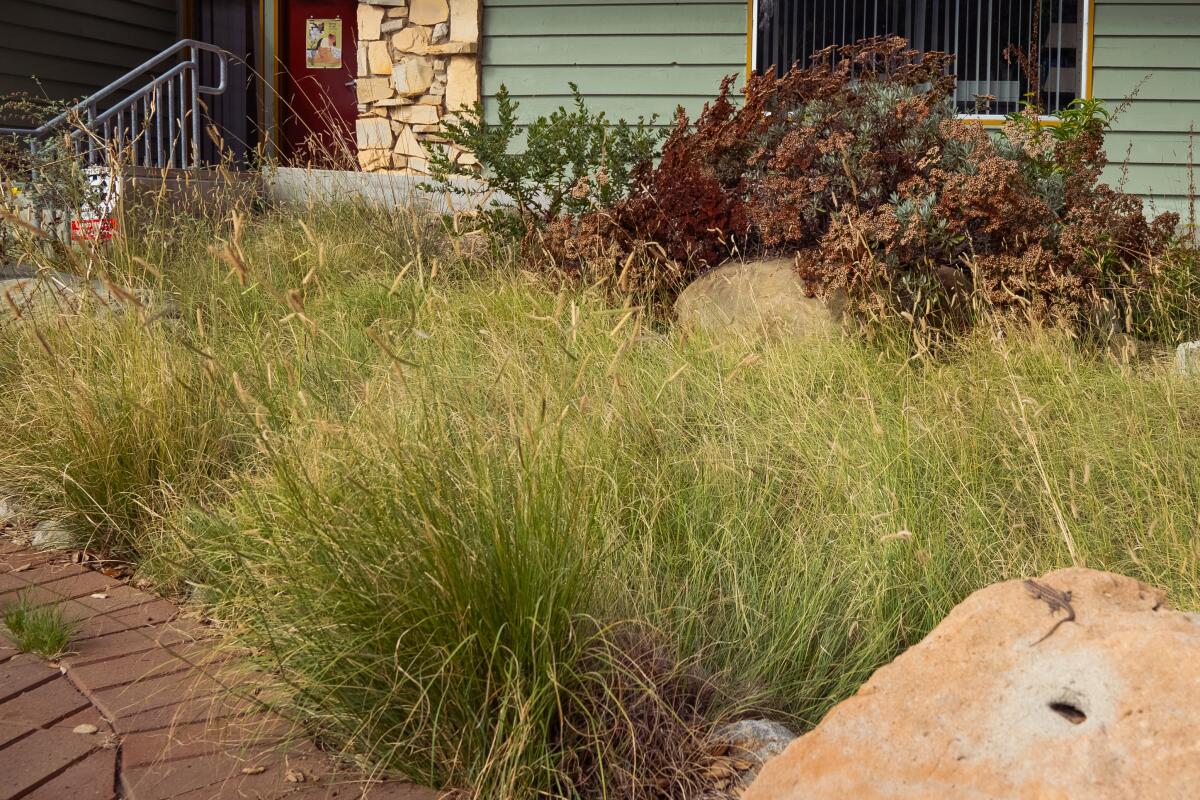
Here are some of their top choices for full sun:
Blue grama grass (Bouteloua gracilis) “I love this fine-textured grass, both for its sage green foliage [I don’t think I’ve ever seen any forms that are blue] and for the whimsical inflorescences (flower clusters),” said Bornstein. “It’s quite versatile either as a bunchgrass or as a low-water alternative to conventional turf. For the latter, I prefer it unmowed because I like the lazy lawn look, but it can be mowed if desired.”
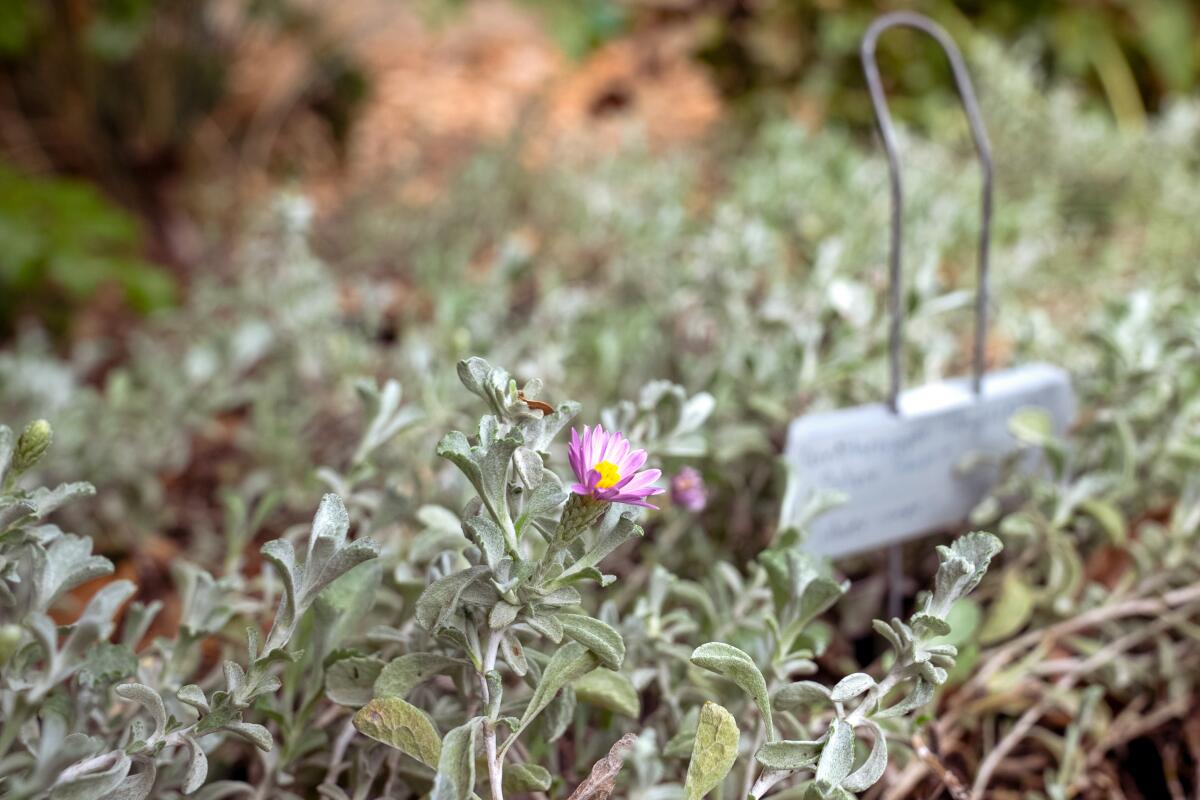
Silver Carpet Aster (Corethrogyne filaginifolia ‘Silver Carpet’) “I think it’s one of the best ground covers we have,” said Becker. “It grows very fast and it blooms when other things are not blooming. You can plant just one if you only need a small section, but if you plant multiples you can create a carpet.” Bornstein said she’s had one in a pot for years. “It looks nice paired with coyote bush or ground-cover forms of ceanothus and manzanita, and it’s great cascading over walls. It also attracts butterflies.”
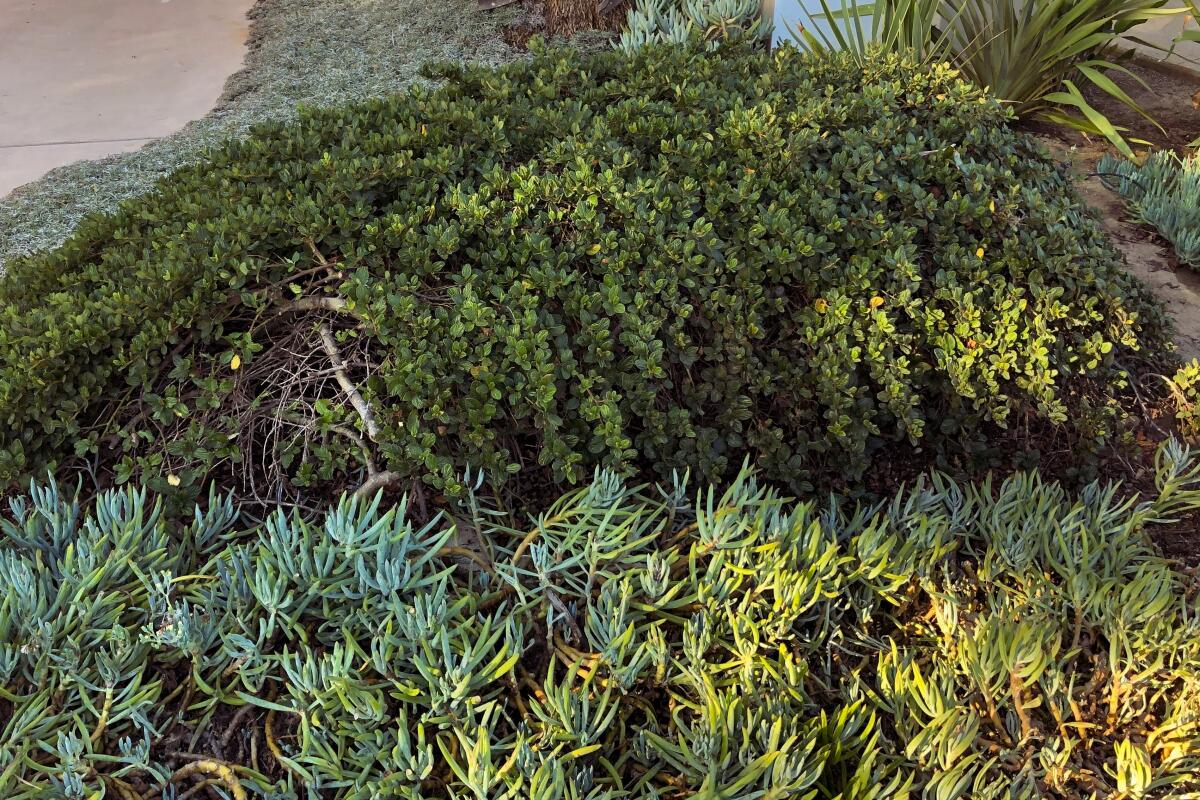
Yankee Point Carmel Ceanothus (Ceanothus thyrsiflorus var. griseus ‘Yankee Point’) Known as California lilac, it comes in so many shapes and heights it’s easy to get confused. Bornstein loves a rare species called maritime ceanothus (Ceanothus maritmus), but there are many other ceanothus ground covers. Yankee Point is one of the most popular, said Meyer and Becker. Still, you should check out Frosty Dawn Mountain Lilac (Ceanothus maritimus ‘Frosty Dawn’), Point Sierra Mountain Lilac (Ceanothus maritimus “Point Sierra”), Valley Violet Mountain Lilac (Ceanothus maritimus ‘Valley Violet’) and Popcorn Mountain Lilac (Ceanothus maritimus ‘Popcorn’). All these cultivars are great for native bees, Bornstein said, “plus the birds eat the seeds.”
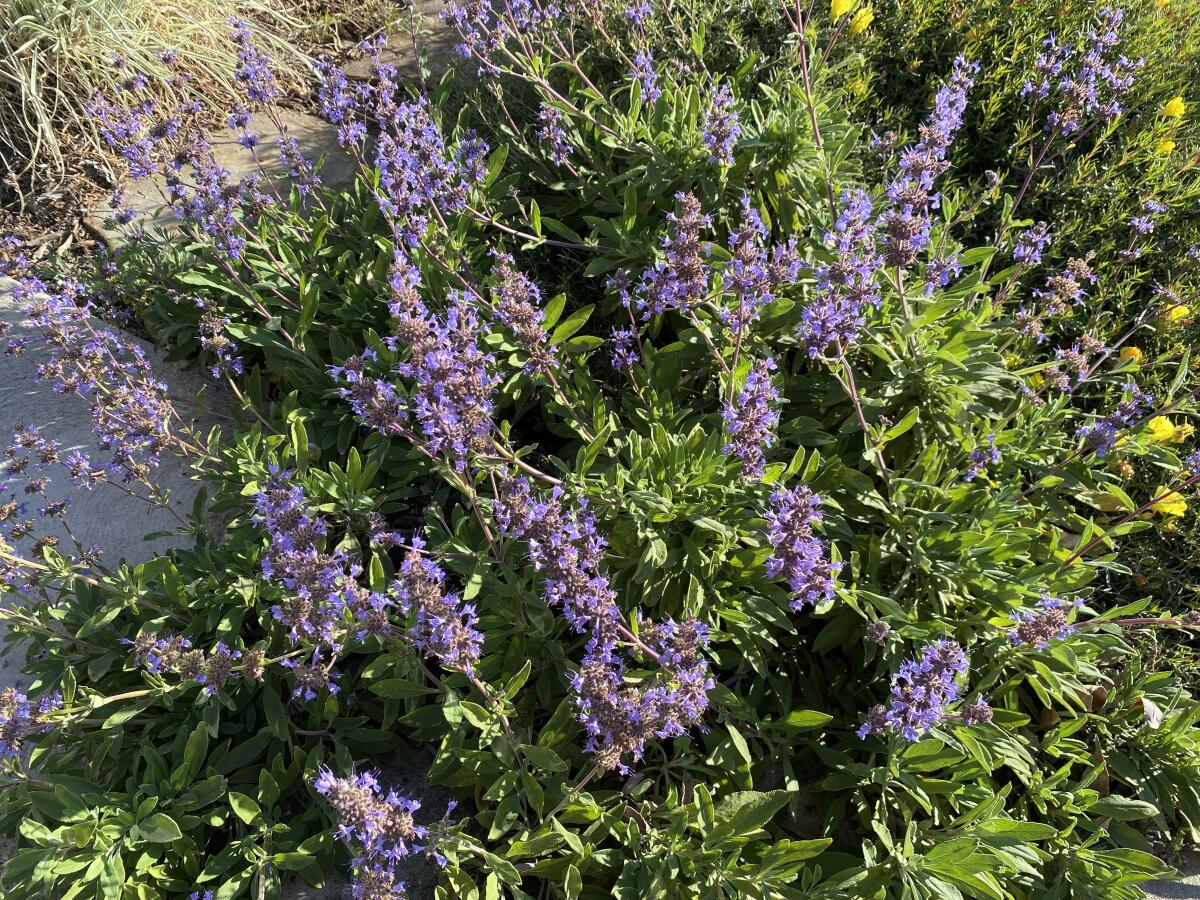
Dara’s Choice Sage (Salvia ‘Dara’s Choice’) is one of Davis’ favorites. “It has a beautiful dark gray-green foliage, and blue inflorescence in the spring through early summer,” he writes. “Its scent, like that of its Cleveland sage parentage, is intoxicating. It grows quickly and can be combined with a little leaved variety like Bee’s Bliss Sage (Salvia x ‘Bee’s Bliss’) for a mottled effect.” These sages pair well with California buckwheat and/or sagebrush too, he said, “for a naturalistic yet tidy look.”
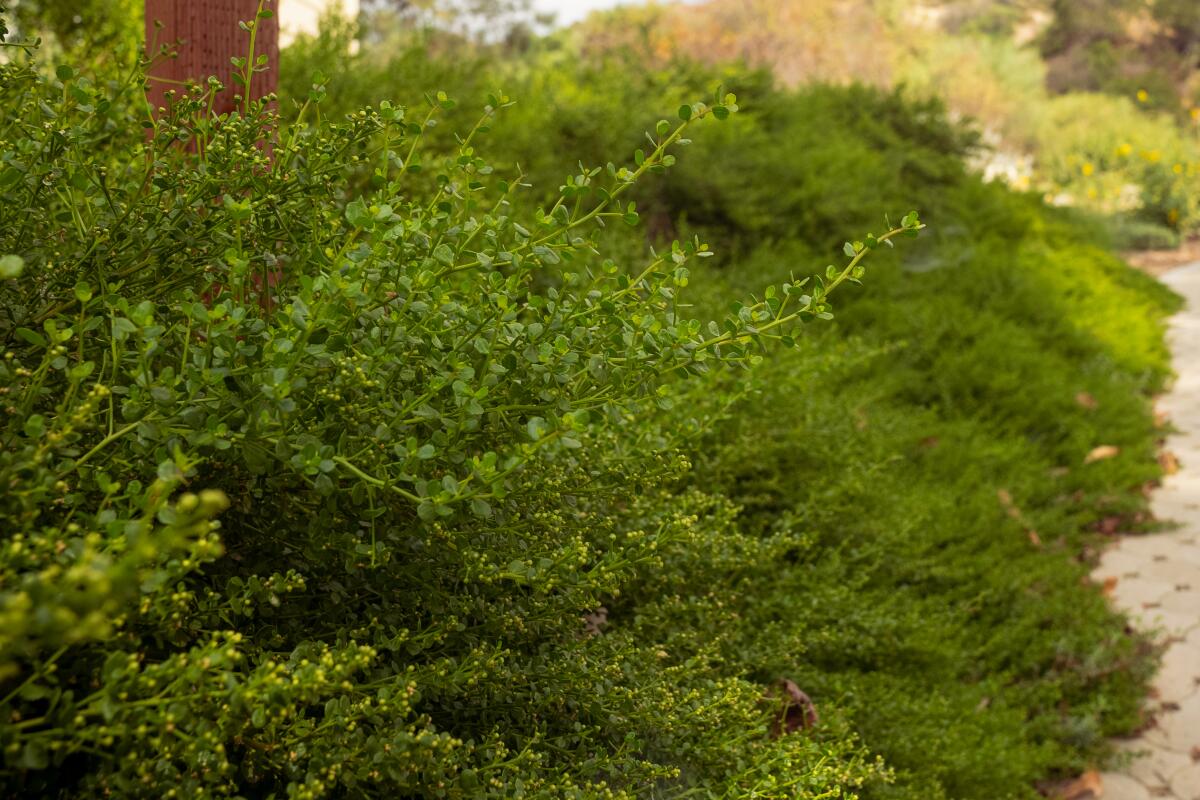
Twin Peaks No. 2 Dwarf Coyote Brush (Baccharis pilularis ‘Twin Peaks No. 2’) and its close cousin, Pigeon Point Dwarf Coyote Brush (Baccharis pilularis ‘Pigeon Point’) are so perfectly green and compact they look like the perfect landscaping plants. “Despite the fact that the flowers are inconspicuous, they’re pollinator magnets and they bloom for a very long time,” Becker said.
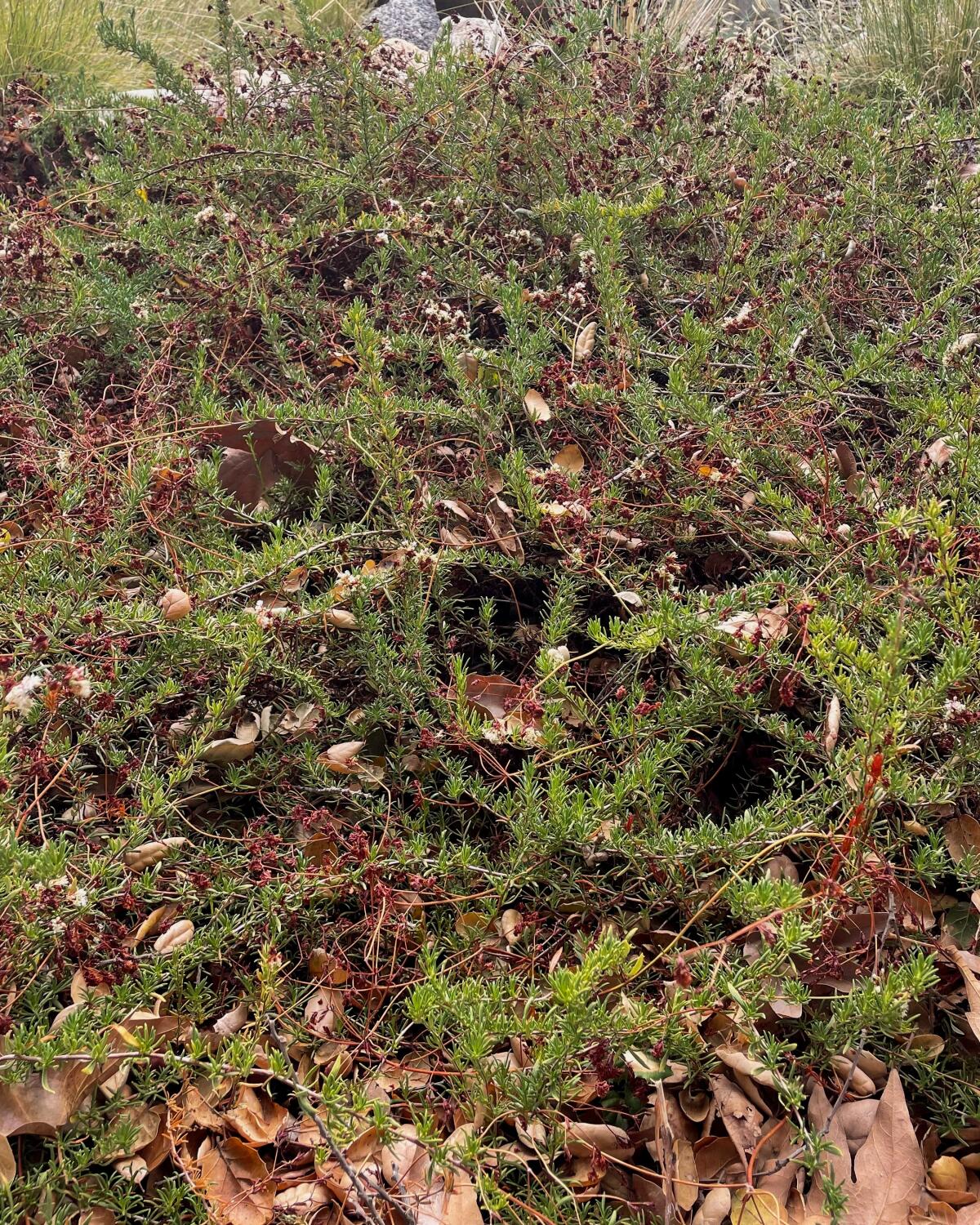
Theodore Payne buckwheat (Eriogonum fasciculatum ‘Theodore Payne’) is a cultivar of California buckwheat (Eriogonum fasciculatum), which can grow up to 6 feet tall. The Theodore Payne also blooms profusely but hugs the ground. “It’s giving you really good habitat and food for pollinators while doing that aesthetic thing of looking good while it’s growing,” Meyer said. Becker says there are several other ground cover buckwheats to consider, from showy red-flowered buckwheat (Eriogonum grande var. rubescens) to bright green leaves of Warriner Lytle Buckwheat (Eriogonum fasciculatum ‘Warriner Lytle’).
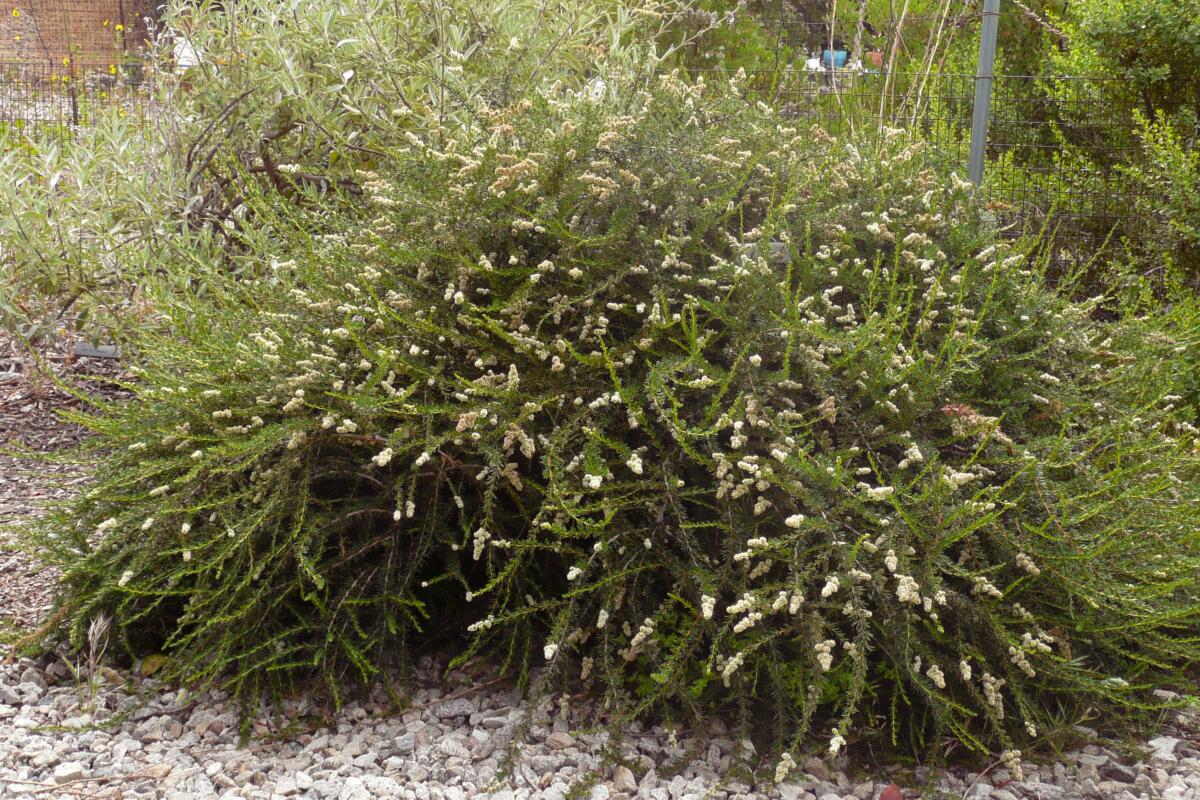
Nicolas chamise (Adenostoma fasciculatum ‘Nicolas’) is one of those handsome cultivar shrubs that get about 2 feet tall but twice as wide. Meyer said it’s “a tough, woody plant that is really low-maintenance. “
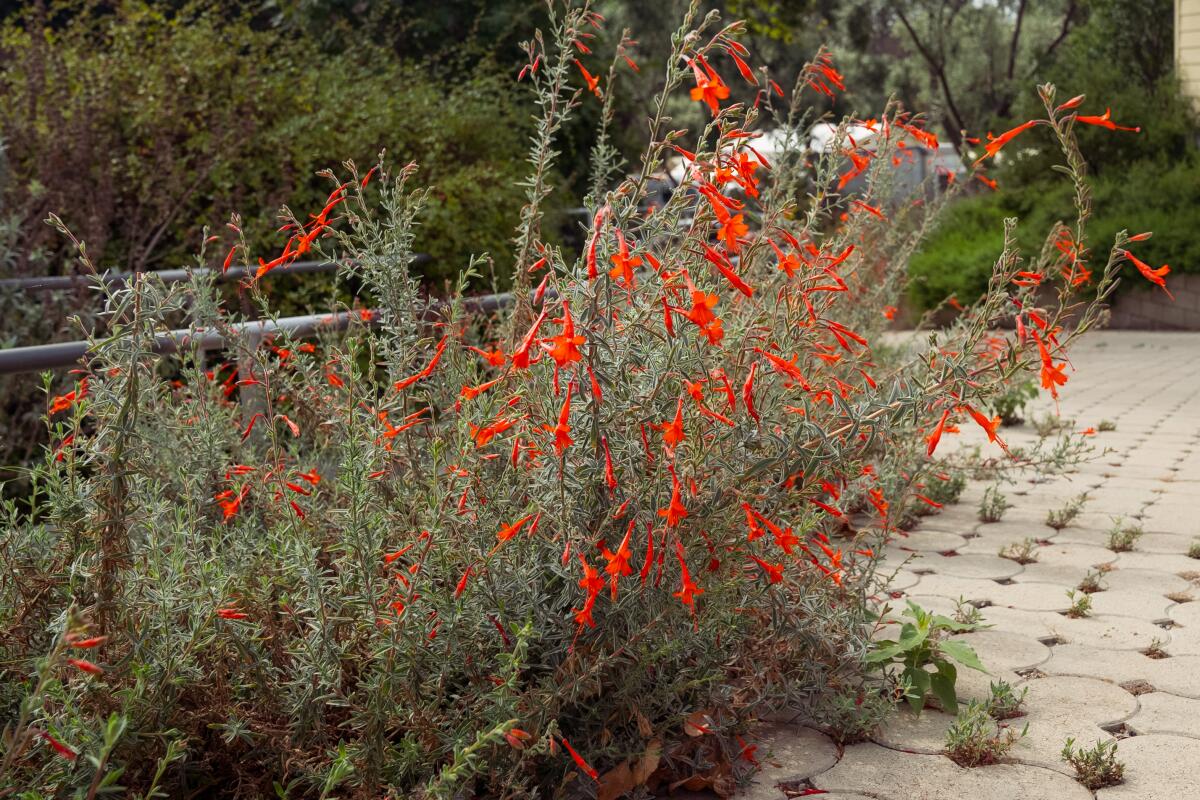
California fuchsia (Epilobium-canum) can look a little weedy in spring and early summer. In late summer when most plants have stopped flowering, this low-to-the-ground perennial is covered with bright red blooms. California fuchsia is a great habitat plant because it provides food for pollinators when there isn’t much else, Meyer said. They come in many varieties and maintenance is easy.
California native plants have many pros, but their potent scents are the biggest draw of all. Gardening experts share the most fragrant native plants.
John Dourley Manzanita (Arctostaphylos ‘John Dourley’) is one of several low-growing manzanitas recommended by Becker. “There are so many to choose from, you could get lost in this world,” he said. John Dourley, Pacific Mist Manzanita (Arctostaphylos ‘Pacific Mist’) and Radiant Bearberry Manzanita (Arctostaphylos uva-ursi ‘Radiant’) are his three favorites. These are another set of woody shrubs that grow far wider than their height of 1 to 2 feet. They are beautiful to behold with their clusters of fairy-lantern flowers and provide food and shelter for birds and beneficial insects.
For people who need ground covers in shady areas, here are some of their top choices:
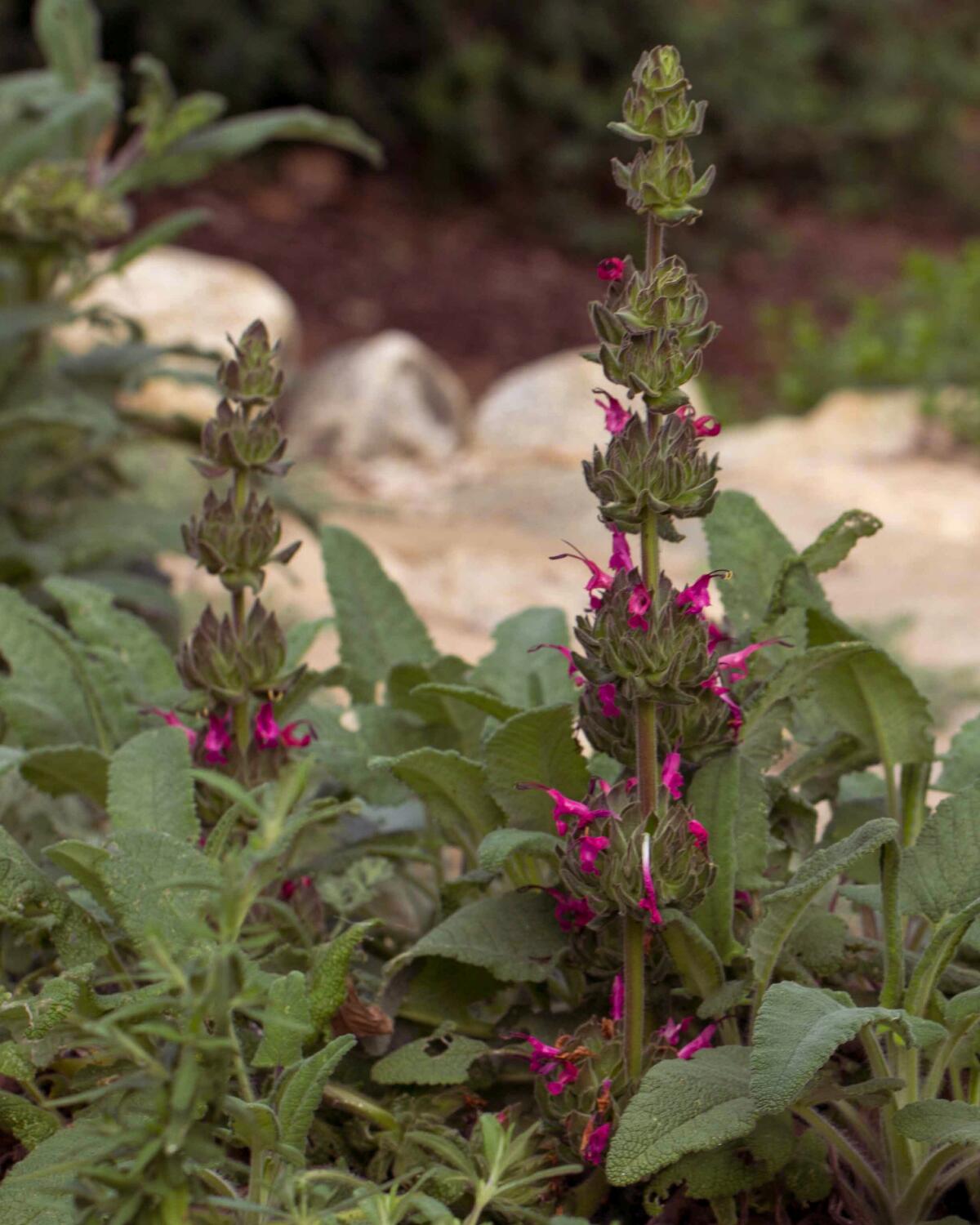
Hummingbird sage (Salvia spathacea) is beloved for its intoxicating fragrance and its showstopper magenta blooms. It spreads easily, and can grow best in dappled shade, Becker said.
Creeping Snowberry (Symphoricarpos mollis) has soft green foliage and creamy white berries that emerge in the summer, Becker said. Animals can eat them but not humans.
Creeping barberry (Berberis aquilifolium repens) (also known as Dwarf mahonia) is great under oaks and pines, a lovely spreading shrub that provides food for animals and fall colors when its green leaves turn red.
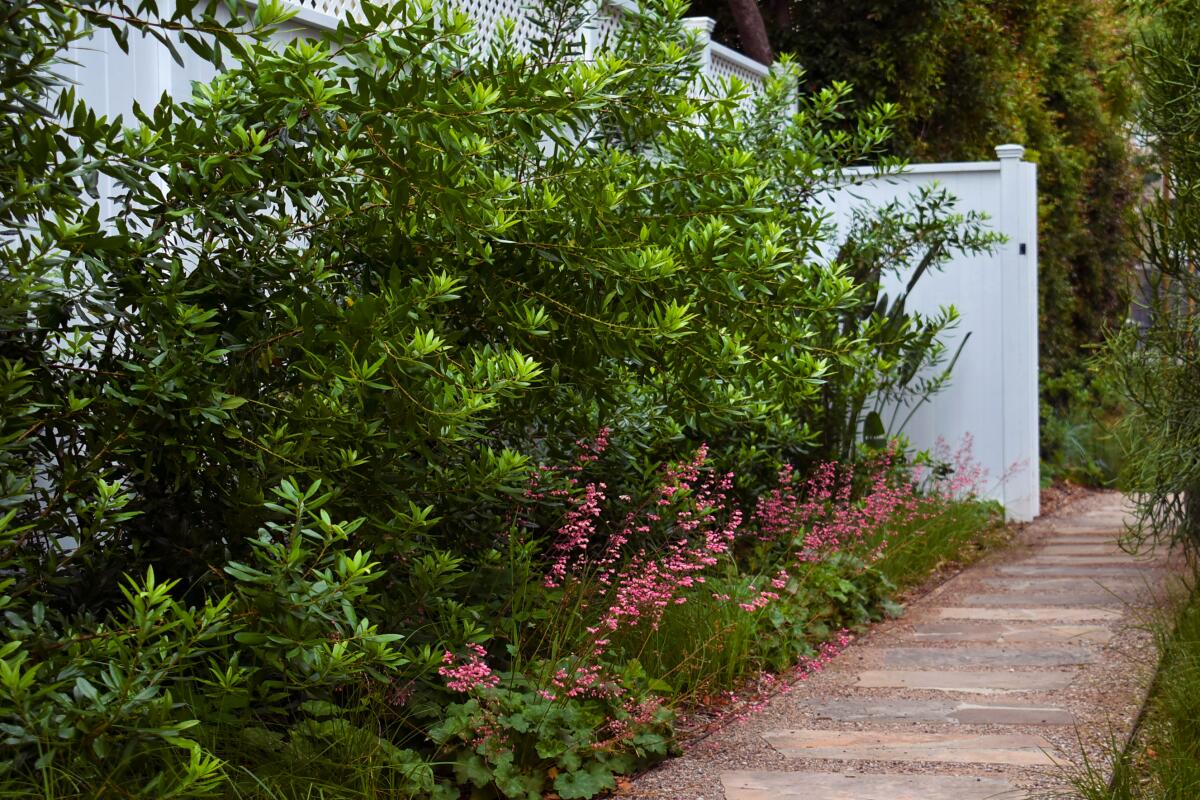
Wendy coral bells (Heuchera ‘Wendy’) have dainty bright pink flowers popular with hummingbirds and look lovely grown en masse in a shady area, Meyer said.
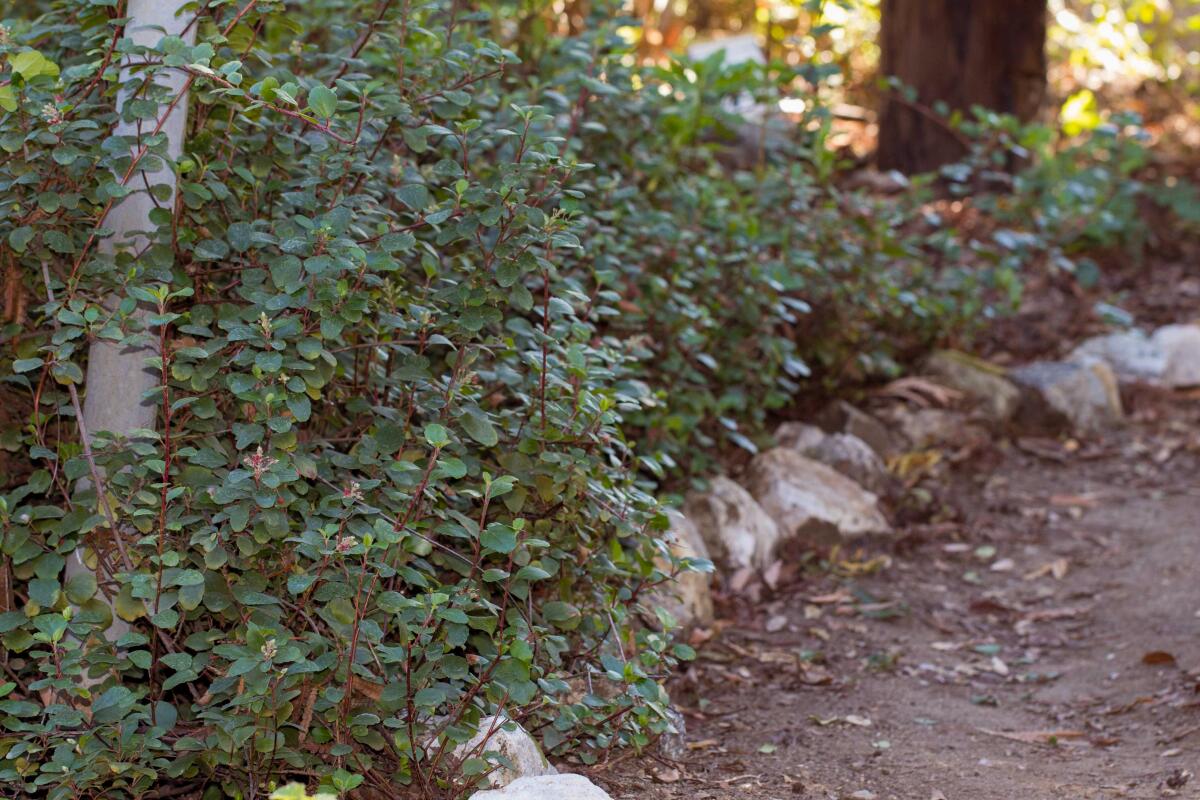
Catalina currant (Ribes viburnifolium) aren’t just handsome low-growing shrubs with sweet pink flowers, they also have berries that feed birds and a delicious fragrance.
Just to make things sweeter, note that many native plant nurseries have special sales events planned for October and November. The California Botanic Garden, California’s largest botanic garden devoted to native plants, reopens its Grow Native Nursery on Oct. 14. The Palos Verdes Peninsula Land Conservancy hosts native plants sales on Oct. 14 at George F Canyon Nature Center and Preserve from 10:30 a.m. to 1 p.m. and Oct. 28 at White Point Nature Education Center from 10:30 a.m. to 1 p.m. The Theodore Payne Foundation is offering a 10% discount (15% for members!) during its Fall Plant Sale Oct. 24-Nov. 4. The Tree of Life Nursery in San Juan Capistrano has a Re-Wild event on Nov. 11, featuring plant sales and presentations. Hardy Californians Nursery reopens Nov. 1 at its pop-up location in Sierra Madre. If you want to see these plants growing, take a stroll through Theodore Payne’s grounds and the California Botanic Garden.
Consider subscribing to the Los Angeles Times
Your support helps us deliver the news that matters most. Become a subscriber.
Upcoming events
If you have an upcoming event you’d like to include in next month’s calendar, email the information to [email protected] by the third week of October, and we’ll try to include it. Feel free to share this email with friends, and encourage them to subscribe too.
October into November
UC Master Gardeners of Los Angeles County Grow LA Gardens classes, a series of four classes about how to prepare, plant, maintain and harvest vegetable gardens taught in Altadena, Lincoln Heights, Long Beach and Pomona. Some sessions are also available in Spanish. Sessions are $55 or $25, depending on ability to pay. Register online, classes fill quickly. celosangeles.ucanr.edu
Oct. 1
The First Sunday Family Friendly Bird Walk hosted by the Pomona Valley Audubon Society at the California Botanic Garden in Claremont is about two hours long and perfect for beginners and experienced birders alike. Water and binoculars are recommended. 8 to 10 a.m. Free. calbg.org
Oct. 5. 12 and 19
Botanical Lecture Series: The Joys of Planting a Garden, with licensed landscape architect Shelley Sparks. In this three-part lecture series, Sparks will cover what it takes to plan your new garden, soil basics and plant needs, and how to put your stamp on it. Includes after-hours visits through the Huntington’s gardens. 4:30 p.m. $150 ($130 members). huntington.org
Here are the best retail native plant nurseries in Southern California to help you create a habitat for birds and pollinators in your yard or even on a patio.
Oct. 6
Comprehensive Irrigation for California Native Plants, a workshop taught by Theodore Payne Foundation Director of Horticulture Tim Becker, 9 a.m. to noon at the foundation’s classroom and gardens in Sun Valley. Register online $65 ($55 for members). eventbrite.com
Oct. 6-8
Mt. San Antonio College Horticulture’s Fall Plant Sale will include student-raised houseplants, plumerias, succulents, shade plants, sages, agaves, California-friendly plants and specialty plants. 9 a.m. to 4 p.m. at the Arboretum. $15. (Arboretum members free). arboretum.org
Oct. 7 and 14
Certified forest therapy guide Debra Wilbur leads a two-day guided nature walk through the Huntington’s botanical gardens. The immersive forest bathing experience is suitable for all levels, with no previous experience necessary. Registration includes Oct. 7 and 14. 8:30 to 10:30 a.m. $80. ($60 members). huntington.org
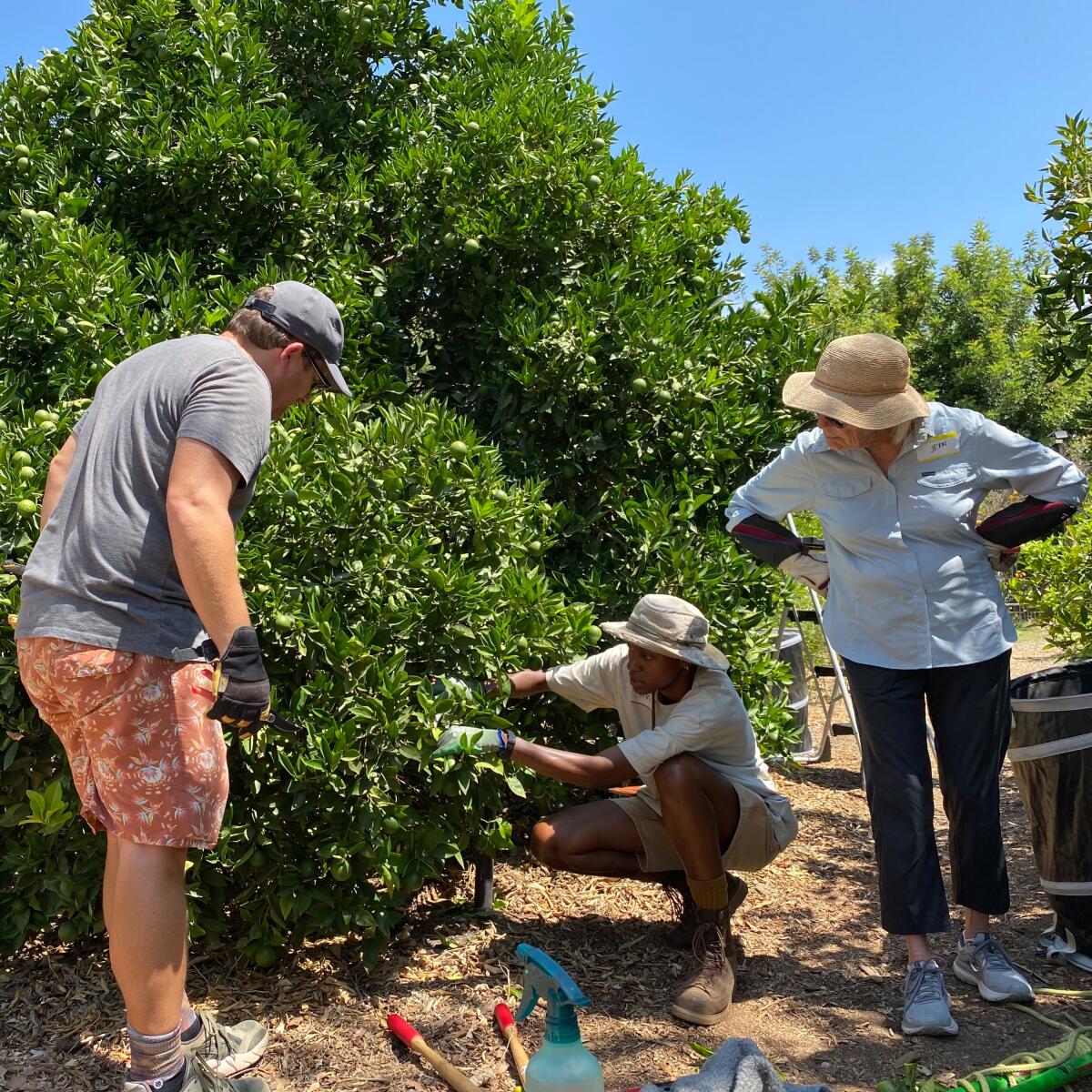
Oct. 7
The Fruitstitute offers a citrus tree pruning 101 class at the Franklin Canyon Orange Grove, one of L.A.’s original citrus orchards in Beverly Hills. 10:30 a.m. to 1:30 p.m. 1400 N. Beverly Drive. Beverly Hills. $50. Also Oct. 21, Nov. 4, Nov. 18 and Dec. 2. fruitstitute.com
That’s SO Cal, an introductory class on growing native plants that covers California’s climate, native plant species and tips on how to select and cultivate native plants. 10 to 11 a.m. at the South Coast Botanic Garden. $30 ($27 members). southcoastbotanicgarden.org
Conor Fitzpatrick of Fig Earth Supply leads a class on planting from seed, covering preparation and materials to sowing options, and the final steps before planting outdoors. $5. 11 a.m. to noon. figearthsupply
A walk with forager Jessica Tsae-Ni Lin in Fox Hills Park reveals a wealth of edible plants. Lin offers queer and BIPOC foraging workshops and even speed dating.
Oct. 7-8
Examples of ikebana, the art of flower arranging, from the Sogetsu School of Ikebana will be on display in the Japanese Garden at Descanso Gardens from 9 a.m. to 5 p.m. Free with admission. descansogardens.org
Oct. 8
Explore ocean-friendly gardens, California native plants, dry riverbeds, and aeroponic vegetable gardens in this self-guided South Bay Water-Wise Garden Tour. The self-driven tour will spotlight gardens in Redondo Beach, Torrance, Gardena and Hawthorne. From 10 a.m. to 4 p.m. $10; children 10 and younger, free. Tickets are available online and on the day of the tour for cash at 16116 Ardath Ave., Gardena.
Oct. 9
Theodore Payne hosts a plant identification walk in the Verdugo Mountains with botanist Terry Huang, who works at the South Coast Botanic Garden as the director of Living Collections, Learning and Engagement. Arrival instructions will be emailed close to the date. Children younger than 7 years old do not need a ticket. 9 to 11 a.m. Stough Canyon Nature Center, 2300 E. Walnut Ave., Burbank. $35 ($25 members). eventbrite.com
Oct. 13
Basics of California Native Plant Maintenance with Anjali Berger. 10 a.m. to noon at the Theodore Payne Foundation gardens in Sun Valley. Register online, $30 ($25 members). eventbrite.com
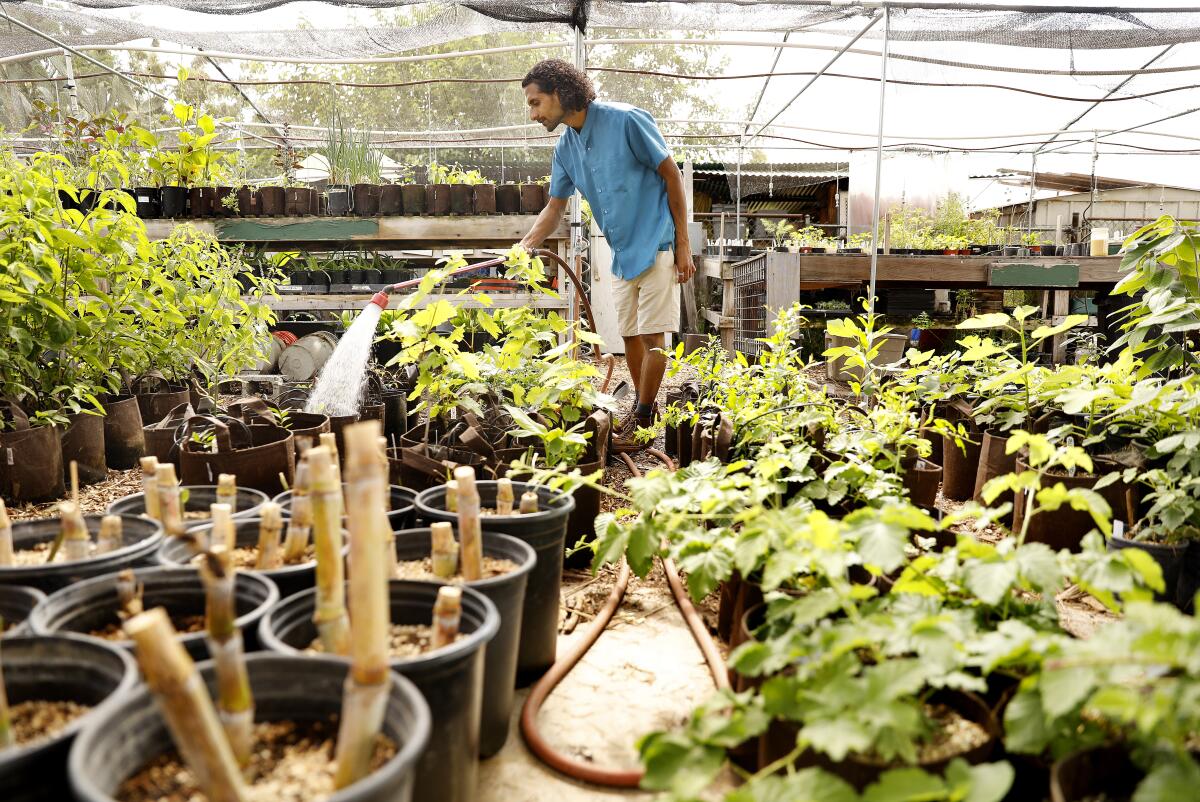
Oct. 14
Southern California Horticultural Society Fall Horticultural Yard Sale at Baker’s Acres, 18552 Erwin St. in Tarzana, 9 a.m. to noon, featuring a wide selection of plants, ceramic pots and garden equipment for purchase. Admission is free. socalhort.org
“Gardening for Birds, Butterflies, Pollinators, and More” at the Waterwise Community Center will offer tips on how to turn your yard into a sanctuary using native plants and special DIY features. 9 a.m. to noon. Free. cbwcd.org
Tour the Sarvodaya Institute farm and nursery in Pomona during its monthly volunteer day. The tour will highlight soil health, creating a habitat and growing food. Tour required for first-time volunteers. Suggested donation for tour: $10 to $20 per person. healinggardens.co
Worm composting, or vermicomposting, turns food waste into worm castings that are great for garden soil. Here’s how to start worm composting at home.
Learn the Okinawan tradition of bokashi composting, an anaerobic process that uses a special additive to ferment kitchen waste in Hiro’s Bokashi Workshop at the Japanese American Cultural & Community Center in Little Tokyo. The workshop is free, but $5 to $10 donations to Sustainable Little Tokyo are encouraged. Supplies to make one bag of bokashi: $5; bokashi kit (a bucket set and bokashi supplies for one bag): $30. Sliding scale for low-income individuals. jaccc.org
Oct. 20-22
Orchid lovers can peruse hundreds of exotic blooms from around the world at the 7th Annual Huntington International Orchid Show and Sale at the Huntington. 10 a.m. to 5 p.m. Free with Huntington admission. huntington.org
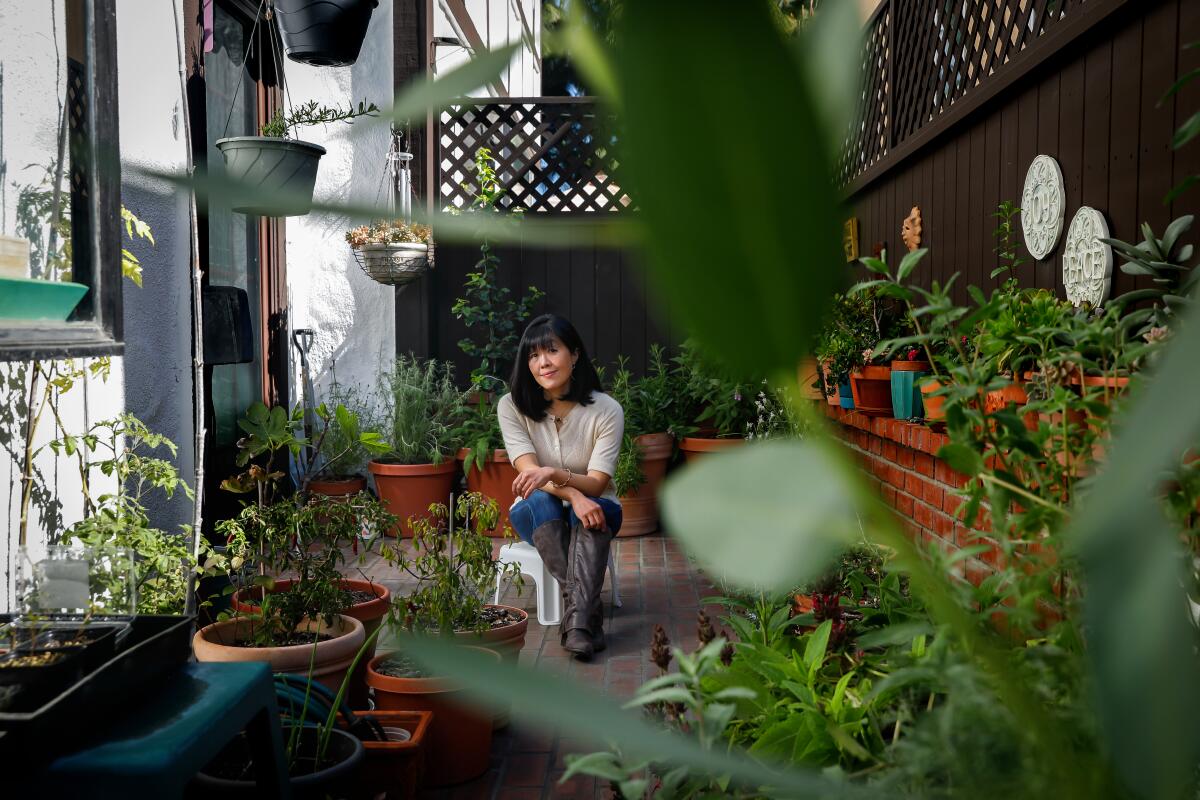
Oct. 21:
Rishi Kumar of Sarvodaya Farm will lead a Zoom presentation on permaculture as part of the Arboretum’s Crescent Farm Workshop series. 10 a.m. to noon. Preregistration is required to receive the Zoom link. The Zoom link will be sent 24 hours before the class. arboretum.org
Barbara Chung fell in love with native plants, but she didn’t have a yard. So she created a habitat garden in pots on her tiny townhouse patio in Santa Monica.
Learn how Barbara Chung turned her townhouse terrace into a container garden of more than 200 mostly California native plants in “A Little Garden’s Story: Habitat in Containers with Barbara Chung.” 10 a.m. Theodore Payne Foundation, 10459 Tuxford St., Sun Valley. $35 (members, $25). theodorepayne.org
Oct. 24
Container Gardening in Southern California with Yvonne Savio, 4 p.m. John Muir Branch, Los Angeles Public Library, 1005 W. 64th St., Los Angeles. Free, (323) 789-4800, [email protected]
Oct. 28
Plant Speed Dating with Agatha Isabel, author of “Houseplant Hookups,” 6 to 7:30 p.m. at Plantitas in Long Beach, allows you to speed date with your wish list plants to learn about their proper care and environment. The $35 ticket includes a copy of Isabel’s book, a Q&A session with the author and light refreshments. You also get 15% off items purchased at Plantitas that evening. eventbrite.com
As the drought continues, Californians are tearing out their lawns. Here’s a DIY guide to killing grass to prep for a drought-tolerant landscape.
“Installation and Establishment of California Native and Waterwise Gardens” at the Waterwise Community Center in Montclair. Learn how to properly prepare your site, install new plants and get your garden off to a healthy start from 9 a.m. to noon. Free. cbwcd.org/workshops
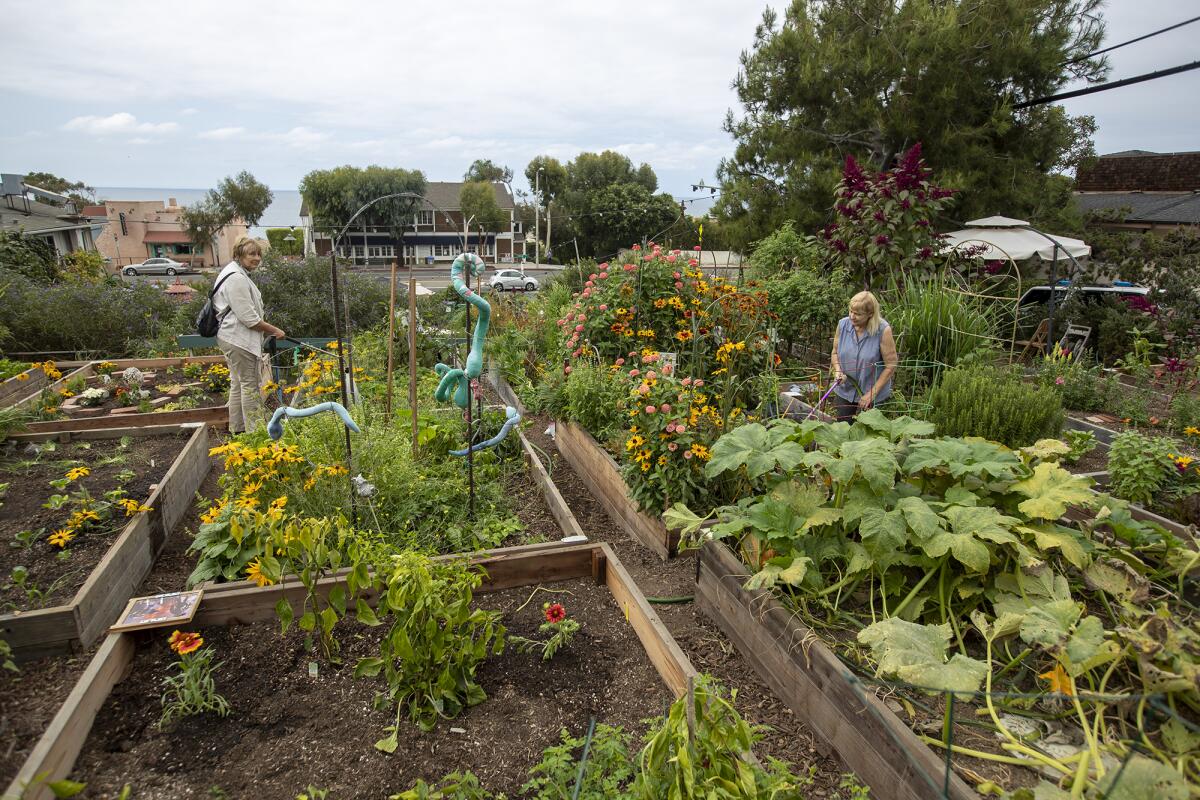
What we’re reading
- Jews need the rare etrog fruit for Sukkot. That’s where a Presbyterian family comes in.
- “Symbol of hope”: Lahaina’s beloved 150-year-old banyan shows new growth after Maui wildfires badly singed it last month.
- Los Angeles, Sacramento, San Diego and other California communities will get $103 million in federal funding for tree planting and other green space. Hayley Smith details how the $1 billion in federal funding will affect Los Angeles.
- Hot-weather cherries, drought-resistant melons and six other crops could change how we eat in a fast-warming world.
- How can the estimated 40 million acres of lawn be reinvented in the United States? Cornell Botanic Gardens is testing sustainable options for replacing backyard grass.
- California will soon outlaw using drinking water for some of those vast expanses of grass — the purely decorative patches of green that are mowed but never walked on or used for recreation.
- On the heels of a record-setting wet and warm August, forecasters have announced that El Niño is getting stronger, and odds are tilting toward another wet winter for California.
- Mosquitoes in L.A. are bad right now. Lila Seidman researched why mosquitoes — including the ankle-biting Aedes — are skyrocketing.
Sign up for The Wild
We’ll help you find the best places to hike, bike and run, as well as the perfect silent spots for meditation and yoga.
You may occasionally receive promotional content from the Los Angeles Times.
